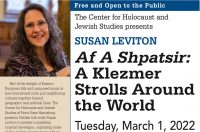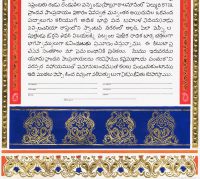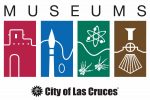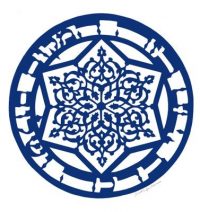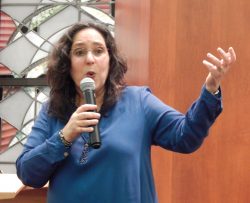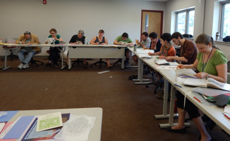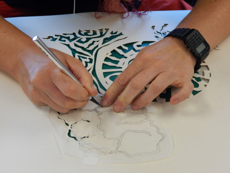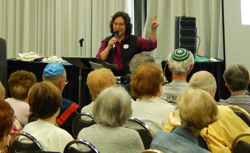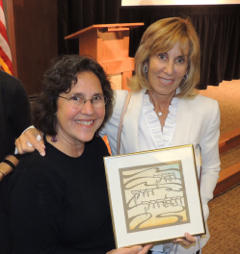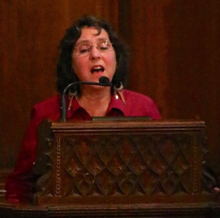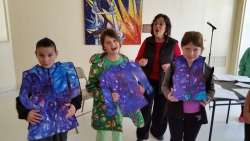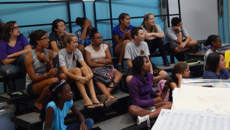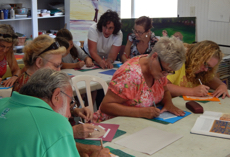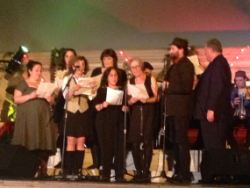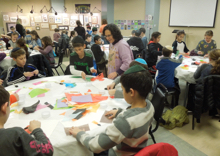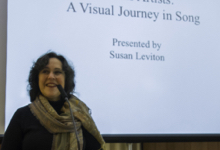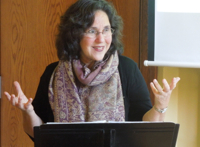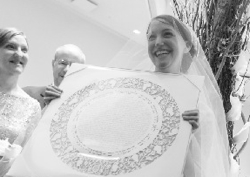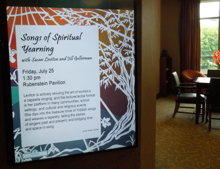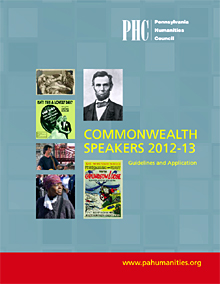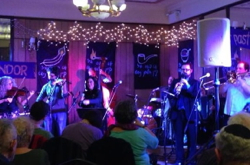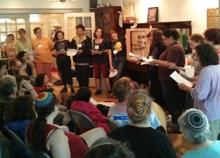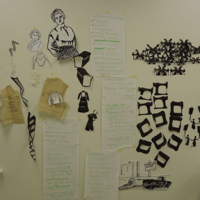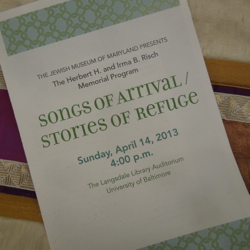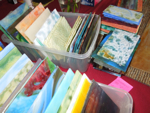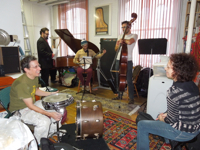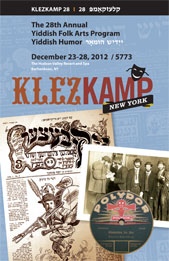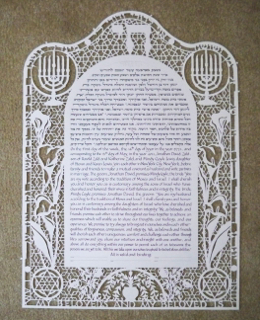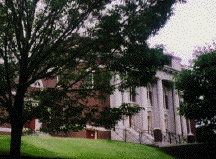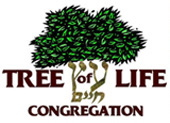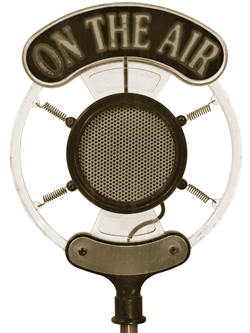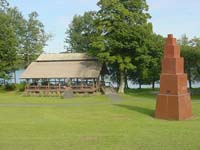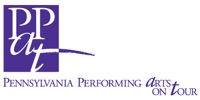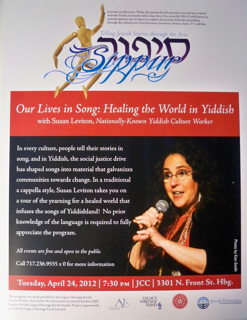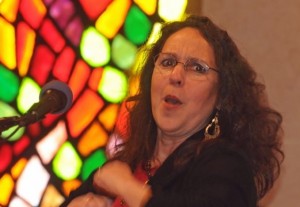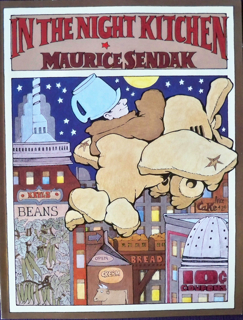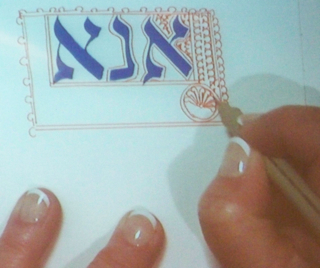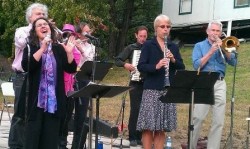Are you looking for a stimulating program to bring to your organization, university or community? Take a look below at the visual arts programming I offer and be sure to look into residency opportunities which would allow you to showcase a range of Yiddish folk arts activities including lectures on historic and contemporary Judaica, lecture recitals appropriate for all audiences, and hands on workshops in both the arts and in musical repertoire!
The visual arts lecture/demonstrations and workshops described below are samples of an increasing array of programs. I’m happy to work individually with presenting organizations to develop unique programs to meet your needs and goals.
__________________________
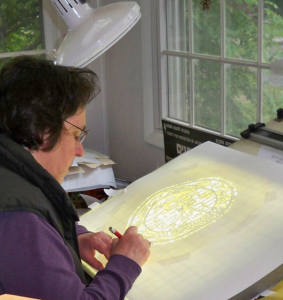 1. The Art of Jewish Papercutting—Papercutting is unique in Jewish life because it’s generally text-based and designed for ritual or seasonal use. The program begins with a whirlwind slide tour of the history of papercutting throughout the world, and then moves through a stunning array of historic Jewish papercuts from Eastern Europe, North Afric
1. The Art of Jewish Papercutting—Papercutting is unique in Jewish life because it’s generally text-based and designed for ritual or seasonal use. The program begins with a whirlwind slide tour of the history of papercutting throughout the world, and then moves through a stunning array of historic Jewish papercuts from Eastern Europe, North Afric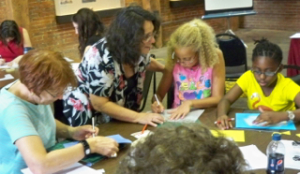 a and the Americas. Contemporary cuts are also featured, and I always bring a sampling of my own framed work to discuss as well. Given time, a follow-up hands on workshop (ages 10 and up) may be scheduled.
a and the Americas. Contemporary cuts are also featured, and I always bring a sampling of my own framed work to discuss as well. Given time, a follow-up hands on workshop (ages 10 and up) may be scheduled.
2. Contemporary Judaica – How We Got From There to Here! —Take a virtual tour through a Jewish gift shop of the 1950s and move through the decades to the current explosion of fine crafted and meaningful objects of Jewish art and expressions through dance, music, liturgy, literature and architecture – oh, and the kitsch that comes along for the ride. (Besides a promo image of a life-size Chanukah Dreydl Tree from the late 50’s, I will also share my current favorite artifact with you: the Bat Mitzveh Zombie Bookend, circa 1963!) I’ll highlight the cultural milestones that I believe track the development of finely crafted Jewish ritual art as a parallel to developments in the larger community. A follow-up discussion of what it means to be a Jewish artist and what constitutes “Jewish” art is presented with a natural segue way.
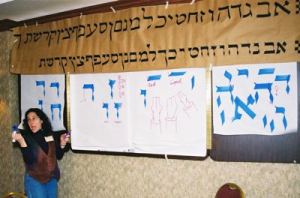
3. Hebrew Lettering—I offer a live demonstration of lettering styles, tools, and applications through an examination of historic and contemporary decorative Hebrew lettering. Participants may join the party as anachronisms in the 21st century by trying their hands, quite literally, at this ancient form of ‘texting’!
I frequently take on groups of students who wish to learn a particular Hebrew lettering style and would be happy to discuss a multi-day lettering arts class.
4. Mosaic – The World’s Most Permanent Form of Painting – For millenia, people have assembled mosaics starting with pebbles and seashells. The art has evolved to provide us with a beauty and history that spans the globe as well as time. The Jewish contributions are indeed rich and surprising. As a mosaicist, I offer this program to send us soaring through that history and learn with ‘new eyes’ how to read mosaics and to notice where Jewish mosaics are still making powerful contributions. The program may include a ‘please touch’ display and demonstrations in hand-cut art glass. Appropriate for all ages!
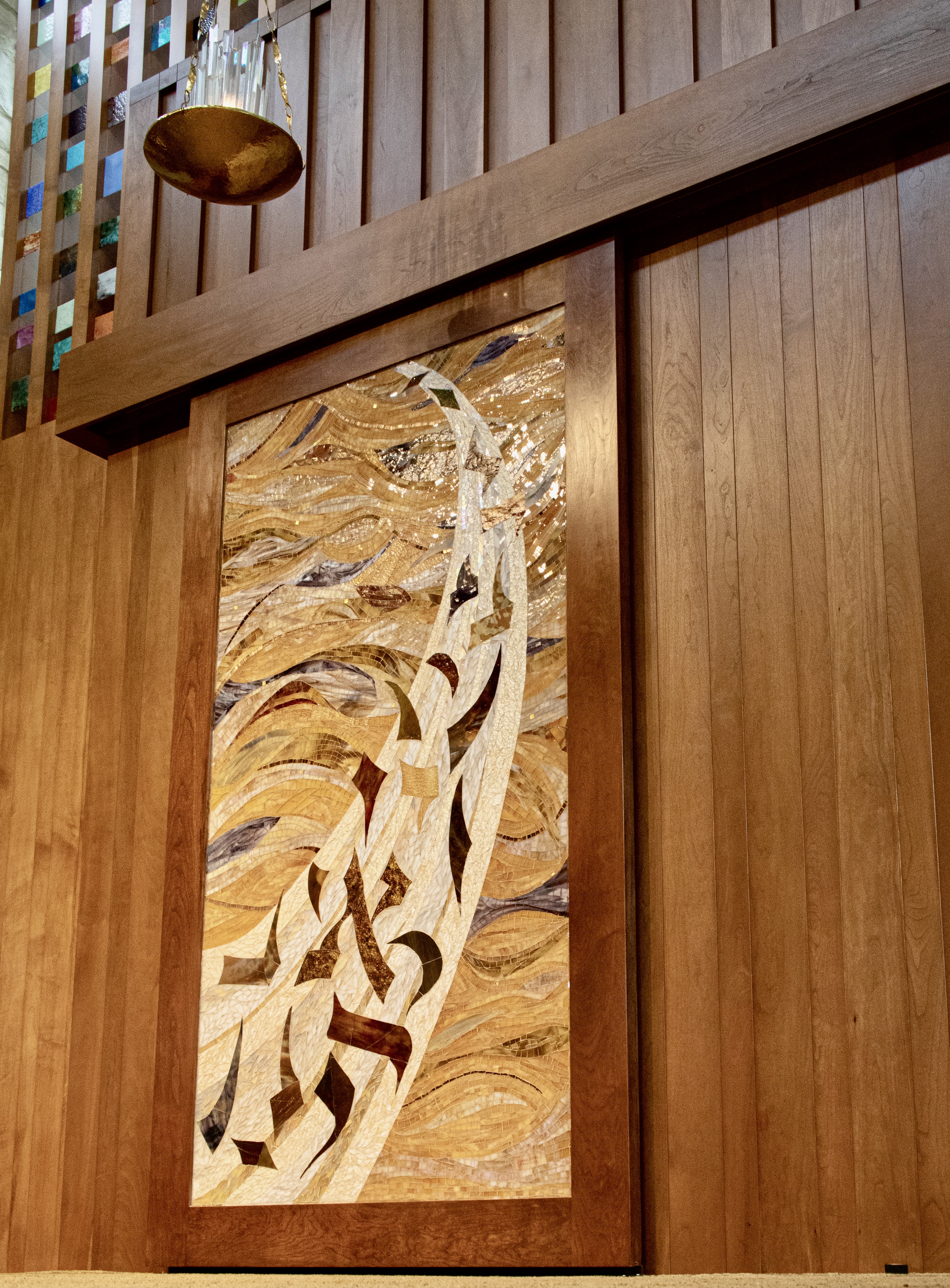
5. Making Midrash Mine—Working with a traditional text, participants create bright and individual art works using torn tissue paper and glue. The program provides opportunities to engage minds and hearts in a quiet examination of one aspect of Jewish tradition while celebrating personal visual expression. This program is suited for a Saturday evening after Shabbat, or as a Sunday morning family workshop. I will be glad to work with a topic of your choice or to suggest something during the planning phase for your event.
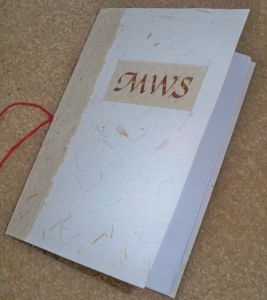 6. Hand-Made Books—Each workshop participant creates a simple hand-sewn book signature with a decorative cover, inside leaf, and personalized binding cords. The books make wonderful journals or photo albums. This is a relatively short workshop and may be added as the culmination of a papercutting or lettering arts series, giving students a beautiful showcase for their new skills.
6. Hand-Made Books—Each workshop participant creates a simple hand-sewn book signature with a decorative cover, inside leaf, and personalized binding cords. The books make wonderful journals or photo albums. This is a relatively short workshop and may be added as the culmination of a papercutting or lettering arts series, giving students a beautiful showcase for their new skills.
7. The Art of the Ketubah—The ketubah, (Jewish marriage contract) is a legally bindin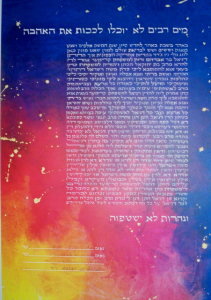 g document but is not considered a religious one, therefore it is not bound by the restrictions that apply to sacred writings. And so, for many hundred years, the Jewish marriage contract has been an outlet and a record of artistic expression, conveying precious visual information about where Jews have lived in proximity to other cultures. Through a thorough and surprising series of slides, participants will learn what encouraged artists to use the materials and images of their times to craft a vibrant record of their own communities. Of great interest is the examination of contemporary American ketubot and how their design, language, and materials set them absolutely in this time and place.
g document but is not considered a religious one, therefore it is not bound by the restrictions that apply to sacred writings. And so, for many hundred years, the Jewish marriage contract has been an outlet and a record of artistic expression, conveying precious visual information about where Jews have lived in proximity to other cultures. Through a thorough and surprising series of slides, participants will learn what encouraged artists to use the materials and images of their times to craft a vibrant record of their own communities. Of great interest is the examination of contemporary American ketubot and how their design, language, and materials set them absolutely in this time and place.
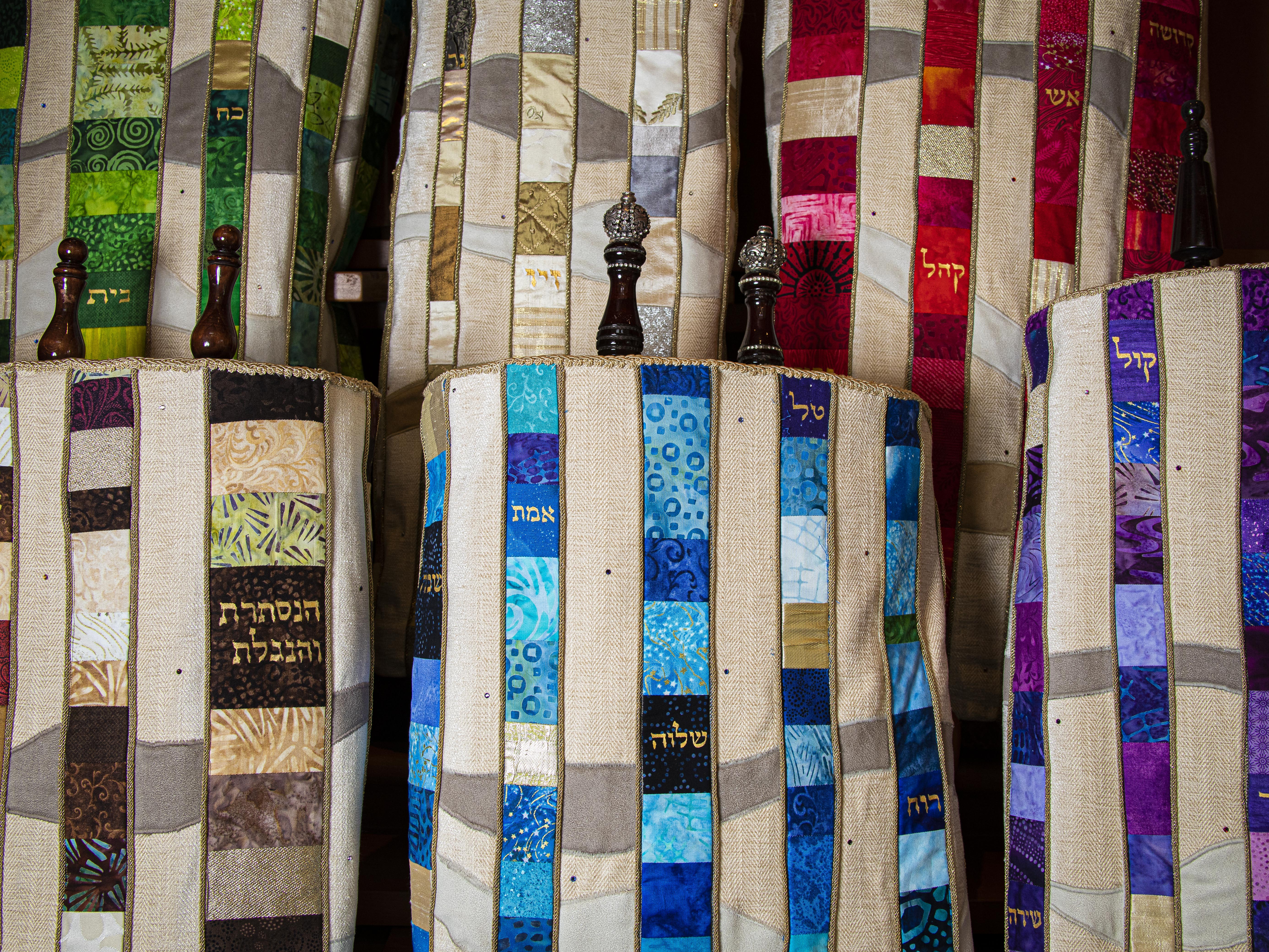 8. Needlework in Jewish Life—From first references in the Torah, through elaborate fabric embellishments from Europe, northern Africa, and the Far East, and into contemporary ritual art, participants will examine the place of the needle and thread in the fabric of our lives. The lecture begins with a brief examination of how Jews in Europe and the Middle East began their business connections with fiber, and moves into the ‘shmatta business’ in New York and the implications for the labor movement. Beyond the expected (e.g. the tallit or prayer shawl, and the parochet or curtain in the ark), we will examine recently revived ritual fabric objects like the beyn gavra, the cloth that covers the Torah between readings, and the Kol HaNa’arim, a special canopy raised on Simchat Torah when children come up to the Torah en masse for a special blessing. Examples of fabric art are provided for participants to hold and compare. Participants may wish to bring fiber ritual objects from home, new or heirloom, to spark more personal discussions.
8. Needlework in Jewish Life—From first references in the Torah, through elaborate fabric embellishments from Europe, northern Africa, and the Far East, and into contemporary ritual art, participants will examine the place of the needle and thread in the fabric of our lives. The lecture begins with a brief examination of how Jews in Europe and the Middle East began their business connections with fiber, and moves into the ‘shmatta business’ in New York and the implications for the labor movement. Beyond the expected (e.g. the tallit or prayer shawl, and the parochet or curtain in the ark), we will examine recently revived ritual fabric objects like the beyn gavra, the cloth that covers the Torah between readings, and the Kol HaNa’arim, a special canopy raised on Simchat Torah when children come up to the Torah en masse for a special blessing. Examples of fabric art are provided for participants to hold and compare. Participants may wish to bring fiber ritual objects from home, new or heirloom, to spark more personal discussions.
9. The Unexpected Journeys of the Sarajevo Hagaddah—The actual historic record of the Sarajevo Hagaddah always astounds the audience as I weave the tale of unlikely rescuers of the book. Th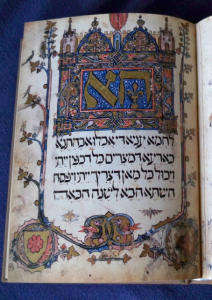 is program incorporates lettering and gilding demonst
is program incorporates lettering and gilding demonst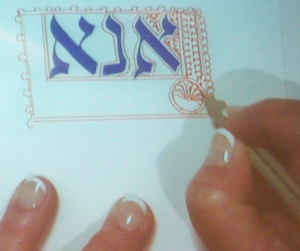 rations in the style of the mid-14th century Sarajevo Hagaddah believed to have been written and illuminated in Spain. and also includes an added treat to this otherwise visual feast in the form of Passover songs from many of the places in which the Sarajevo Hagaddah found a home as described in Geraldine Brooks’ People of the Book. The songs include melodies in the Judeo-Spanish dialect of Sarajevo, and Hebrew, English, and Yiddish songs relating to Passover and the expulsion from Spain. Translations are shared in PowerPoint. Facsimile editions of the Sarajevo Hagaddah and others from the 16th and 17th centuries are available for examination.
rations in the style of the mid-14th century Sarajevo Hagaddah believed to have been written and illuminated in Spain. and also includes an added treat to this otherwise visual feast in the form of Passover songs from many of the places in which the Sarajevo Hagaddah found a home as described in Geraldine Brooks’ People of the Book. The songs include melodies in the Judeo-Spanish dialect of Sarajevo, and Hebrew, English, and Yiddish songs relating to Passover and the expulsion from Spain. Translations are shared in PowerPoint. Facsimile editions of the Sarajevo Hagaddah and others from the 16th and 17th centuries are available for examination.
10. I.B. Singer and his Artists – The lengthy writing career of Nobel Laureate Isaac Bashevis Singer fills bookshelves, and provided dozens of artists with opportunities to filter Singer’s visions through their own artistic sensibilities as his illustrators. Some were friends, like Rafael Soyer and Ira Moskowitz, and some became friends after finding shared roots, like Maurice Sendak. Some shared visions of life in Poland like Irene Leiblich, while some, like Margot Zemach, chosen by Singer’s publishers, brought a folkloric vision to the stories. Still others, like Eric Carle, carried Singer’s words into 21st Century American homes in a bold break from the color palette of Poland. This presentation is a a collage of sound and image, as Susan speaks and sings her way through Singer’s stories and memoirs, accompanied by painted images from his books and Yiddish songs old and new which stitch the visual and aural together.
11. The Wimple – Women’s Art: from the past to the present! In both the Sephardi and Ashkenazi traditions, the Torah binder or wimple was a recognized outlet for women’s needlework creativity. In the Germanic tradition, the linen cloth used to wrap a baby boy at the time of his bris was later cut into strips, elaborately embroidered and finished, and presented to the shul as a Torah binder to be used when the child was called to the Torah as a Bar Mitzvah. In the Sephardi tradition, wealthy women sometimes used the wimple as an opportunity to make singularly personal contributions of ritual art to their congregations. Today the wimple tradition is being revived and this workshop provides not only history, but also a hands-on component tailored to the participants so that family or congregational binders may be crafted for ritual use. Very accessible! Please contact Susan to discuss the development of a workshop for your organization or group.
12. Words as Homeland: Where Jewish Text, Art and Song Converge to Express a Culture This lecture explores the intersections of artistic traditions in Judaism, Islam, and Christianity by examining geography and political atmosphere over centuries. Glimpses into illuminated manuscripts bring to light the shared visual vocabularies representing vastly different traditions while maintaining connections at their roots. An additional spark in this program is the insertion of a sampling of Jewish songs in Hebrew, Yiddish, Judeo-Spanish, and other languages of ours to reinforce the notion that we carry our history and beliefs in our words as a portable homeland. This presentation may also include a live demonstration of lettering arts and illumination techniques, if requested.

